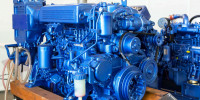How Do Yachts Get Electricity? (3 Surprising Ways)
Yachts require a significant amount of energy to power their various systems, from lighting and air conditioning to navigation and communication equipment. This energy is typically generated by an onboard electrical system. In this article, we'll take a closer look at how yachts get their electricity and explore some surprising ways in which this energy can be generated.
One way to generate electricity in yachts is through onboard generators, either diesel generators or gasoline generators. You can also power your yacht either through lead-acid batteries or lithium-ion batteries. You can also rely on alternative energy sources such as solar panels, wind turbines, or hydro generators.
Yachts can also connect to shore power to get AC power when docked at a marina. Let's explore how this is possible and get to know other ways you can get electricity while in the middle of the sea.
Summary
- Using gasoline generators is easier and requires less maintenance than diesel generators.
- Diesel generators produce less emissions than gasoline generators, making them more environmentally friendly.
- Lead-acid batteries are reliable and relatively inexpensive, but they are heavy, take up a lot of space, have a short cycle life, and require more maintenance than lithium-ion batteries.
- Lithium-ion batteries are more expensive than lead-acid batteries, but they are also more environmentally friendly.
- The National Electric Code (NEC) requires that all 15- or 20-amp service receptacles on a dock be equipped with 5 mA-rated GFCI (Ground Fault Circuit Interrupter) devices to prevent electrical shock or other hazards.

On this page:
Generate Electricity On Yachts Through Onboard Generators
Below is a comparison of two types of generators that are commonly used on yachts:
| Criteria | Diesel generators | Gasoline generators |
|---|---|---|
| Fuel efficiency | More fuel-efficient than gasoline generators, resulting in lower operating costs | Less fuel-efficient than diesel generators, resulting in higher operating costs |
| Power output | Typically higher power output than gasoline generators, making them suitable for larger yachts | Typically lower power output than diesel generators, making them suitable for smaller yachts |
| Maintenance | Require regular maintenance and servicing, but have longer service intervals than gasoline generators | Require regular maintenance and servicing, with shorter service intervals than diesel generators |
| Noise | Tend to be quieter than gasoline generators, making them more suitable for night-time use | Tend to be noisier than diesel generators, making them less suitable for night-time use |
| Environmental impact | Produce less emissions than gasoline generators, making them more environmentally friendly | Produce more emissions than diesel generators, making them less environmentally friendly |
Diesel generators are the most common type of generator used on yachts
Diesel generators are reliable, efficient, and produce a lot of power. Diesel generators work by burning diesel fuel to turn a generator, which produces electricity. They are usually located in the engine room and are connected to the yacht's electrical system.
They come in different sizes and power outputs, so you can choose the one that best fits your needs. They are also relatively quiet and produce less vibration than gasoline generators. However, they do require regular maintenance, such as oil changes and filter replacements.

Want to know the life expectancy of a marine diesel engine and what factors can reduce its overall lifespan? You can read this article.
Gasoline generators are another type of generator that can be used on yachts
Gasoline generators work in a similar way to diesel generators, but they use gasoline instead of diesel fuel. Gasoline generators are smaller and less powerful than diesel generators, but they are also less expensive. A 50-foot yacht will use about 40-50 gallons per hour, based on the costs of buying and owning one.
One advantage of gasoline generators is that they are easier to start and require less maintenance than diesel generators. They are also more lightweight, which can be an advantage on smaller yachts. However, gasoline generators are less efficient than diesel generators and can produce more noise and vibration.
Powering Your Yacht Through Battery Systems
Let's compare the features of the two main types of batteries used on yachts:
| Features | Lead-acid batteries | Lithium-ion batteries |
|---|---|---|
| Energy density | Low | High |
| Weight | Heavy | Light |
| Size | Large | Small |
| Cycle life | Moderate | High |
| Maintenance | High | Low |
| Charging time | Long | Short |
| Discharging efficiency | Low | High |
| Cost | Low | High |
Lead-acid batteries have been the traditional choice for yachts
Lead-acid batteries have been used for decades and are the most common type of battery found on yachts. They are reliable, relatively inexpensive, and can last for several years with proper maintenance.
However, they are heavy and take up a lot of space and their energy density is low, which means they can't store as much energy as lithium-ion batteries. They also have a shorter cycle life and require more maintenance than lithium-ion batteries.

There are two types of lead-acid batteries: flooded and sealed. Flooded batteries require regular maintenance and need to be topped up with distilled water. Sealed batteries are maintenance-free and do not require topping up, but they are more expensive.
Here's what happens to lead acid batteries when you don't winterize your boat.
Lithium-ion batteries are ideal for yachts
Lithium-ion batteries are becoming increasingly popular on yachts due to their high energy density, low weight, and long lifespan. Since they have a higher energy density, it means they can store more energy in a smaller space.
They are also more efficient at discharging, which means you get more usable energy out of them. However, they are more expensive than lead-acid batteries, which can be a significant drawback for some yacht owners.
They are also more environmentally friendly than lead-acid batteries, as they do not contain toxic materials. However, they require careful monitoring and management to prevent overheating and other issues. They also require specialized chargers and should only be installed by a professional.
When winterizing boats with lithium batteries, here's what you need to do.
Alternative Energy Sources For Yachts
Although traditional generators are considered essential for sailboat cruising, there is a rising demand for alternative sources of energy.
Below are three surprising ways to generate electricity on your yacht through alternative energy resources:
| Energy source | Advantages | Disadvantages |
|---|---|---|
| Solar panels | - No fuel costs - Low maintenance - Silent operation - Clean energy - Easy to install |
- Limited power output - Dependence on sunlight - Can be affected by shading - Initial investment cost |
| Wind turbines | - No fuel costs - Low maintenance - Silent operation - Clean energy - Can provide high power output - Suitable for windy areas |
- Dependence on wind - Can be affected by wind direction - Initial investment cost - Requires sufficient space and clearance |
| Hydro generators | - No fuel costs - Can provide high power output - Suitable for boats moving through water - Can operate 24/7 |
- Dependence on water flow - Can be affected by water depth - Initial investment cost - Requires installation on boat hull |
Solar panels are a popular alternative energy source for yachts
These panels are easy to install and can be mounted on various surfaces, including the hull, mast, superstructure, bimini roof, or bow terrace. Solar panels can generate enough electricity to power lighting, appliances, and electronics on board.
One of the advantages of solar panels is that they are silent and have no moving parts, so they require little maintenance. They are also eco-friendly since they don't produce any emissions. Some yachts even use a system to recover heat from the panels to heat up the yacht's boiler, making them even more efficient.

Wind turbines are another alternative energy source for yachts
They are typically mounted on the mast or deck and can generate electricity by harnessing the power of the wind. Wind turbines are best suited for yachts that sail in windy areas.
One advantage of wind turbines is that they can generate electricity even when the yacht is not in use. They are also eco-friendly since they don't produce any emissions. However, wind turbines can be noisy, especially in high winds, and can be a hazard to birds.
Hydro generators are also a considerable energy source for yachts
Hydro generators work by generating electricity from the movement of water as the yacht sails through it. They are typically mounted on the stern and can generate enough electricity to power lighting, appliances, and electronics on board.
Hydro generators are silent and have no moving parts, so they require little maintenance. They are also eco-friendly since they don't produce any emissions. However, hydro generators are best suited for yachts that sail in areas with strong currents, and they can be expensive to install.
Other Sources Of Electricity For Yacht
Below are other possible ways to get electricity in yachts:
Connecting to a shore power source while docking at a marina
Shore power is commonly supplied by a power pedestal or portable generator, which provides alternating current (AC) to your vessel. You need to have accessible shore power at a marina to eliminate fuel consumption when docked for lengthy periods of time.
To connect your yacht to shore power, you will need a shore power cable and a shore power inlet. The cable connects to the inlet on your yacht and the power pedestal or generator on the dock. The inlet is typically located on the transom of your yacht and is designed to withstand the harsh marine environment.
Try to make sure that the shore power cable and inlet are compatible with each other and with the power source. The most common types of shore power connections are 30-amp and 50-amp, with 120-volt and 240-volt options available.
Once connected to shore power, your yacht can run all of its electrical systems, including lights, air conditioning, and appliances, without draining the batteries. Carefully monitor the shore power connection to ensure that it remains secure and that the electrical system is functioning properly.
Using a reverse osmosis system to get electricity in your yacht
This system takes saltwater and forces it through a very fine filter, removing the salt and other impurities. The resulting freshwater can be used for a variety of purposes, including generating electricity.
This method is particularly useful for yachts that spend a lot of time in saltwater environments, as it allows them to generate power without having to rely on external sources. However, it's worth noting that reverse osmosis systems can be quite expensive to install and maintain, so they may not be practical for all yacht owners.
Safety Measures When Powering Your Yacht
Below are a few safety measures you should keep in mind when getting electricity for your yacht:
1. Understand shore power and safety
Shore power is a convenient and efficient way to power your yacht while docked. You could make sure your marina is up-to-date with the latest regulations and safety standards. In addition, always use a marine-rated shore power cord and ensure that it's properly connected to your yacht's electrical system.

2. Installing Ground Fault Circuit Interrupter (GFCI) devices on the dock
Leakage current refers to the flow of electrical current from a circuit or appliance to a ground or other unintended path. This can be a concern when it comes to powering a yacht, as it can lead to electrical shock or other hazards.
To help prevent these hazards, The National Electric Code (NEC) requires that all 15- or 20-amp service receptacles on a dock be equipped with 5 mA-rated GFCI (Ground Fault Circuit Interrupter) devices. These devices are designed to quickly detect and interrupt the flow of electrical current if it detects a ground fault or leakage current, helping to prevent electrical shock or other hazards.
While this requirement may be sufficient for smaller boats with minimal electrical needs, larger yachts may require additional safety measures to prevent electrical shock and other hazards. This can include installing additional GFCI devices, implementing regular electrical safety inspections, and ensuring that all electrical systems are properly grounded and maintained.
3. Other marine electrical safety tips
Here are other important safety tips to keep in mind when it comes to powering your yacht:
- Always use marine-rated electrical equipment.
- Regularly inspect your yacht's electrical system for damage or wear and tear.
- Use a marine electrician for any electrical repairs or upgrades.
- Install a smoke detector and carbon monoxide detector on your yacht.
- Keep a fire extinguisher on board and know how to use it.
To learn more about the three classes of fire extinguishers and other required safety equipment on board, you can refer to this article.
Tips In Maintaining The Electrical System
Here are some tips to keep your electrical system in top shape to ensure its longevity and reliability:
1. Perform regular inspections of your electrical system
Check for any loose connections, corrosion, or damage to the wiring and cables. Also, make sure to inspect the battery terminals for any signs of corrosion, and clean them if necessary.
2. Keep the battery in good condition
The battery is the heart of your yacht's electrical system. Check the battery's water level regularly and top it up if necessary. You could also clean the battery terminals and cable connections to prevent corrosion.
3. Replace worn-out fuse immediately
Fuses protect your electrical components from damage caused by power surges and other electrical issues. Replace any blown fuses immediately to prevent any damage to your electrical system.
4. Call for professional maintenance
It is recommended to have a professional inspect your electrical system periodically. A professional can identify any potential issues that may not be visible during a regular inspection and ensure that your electrical system is in top shape.
Did you find the answer to your specific question?
👍 0 👎 0




Leave a comment